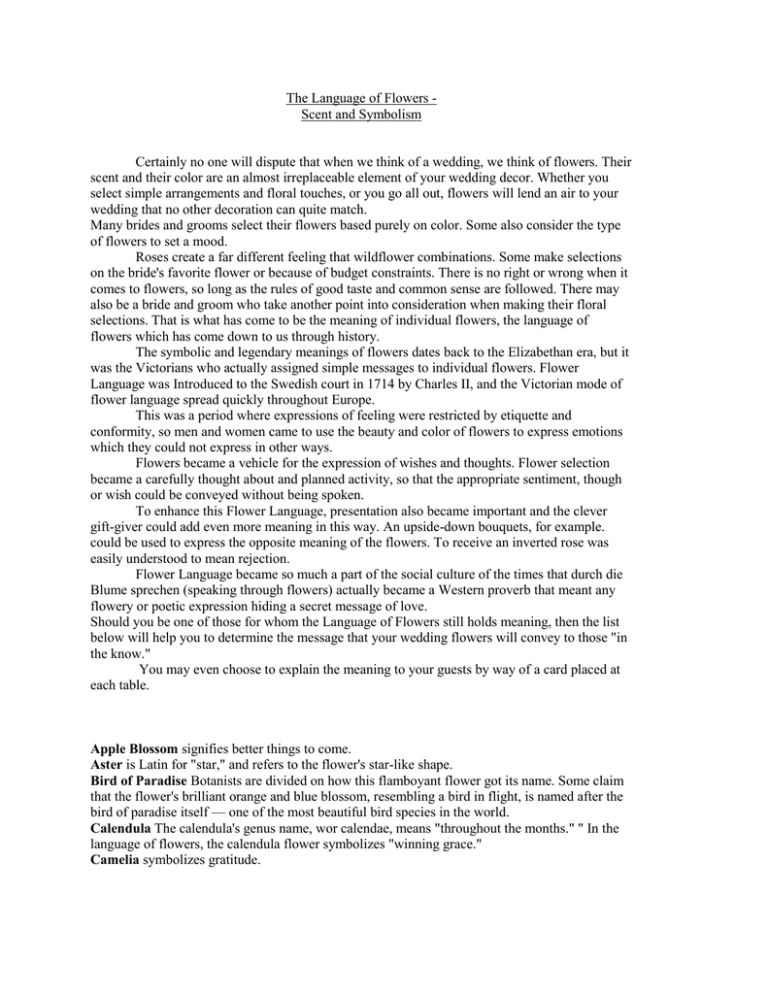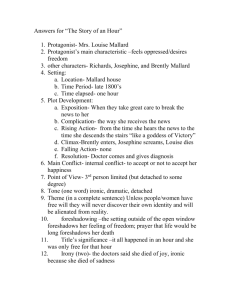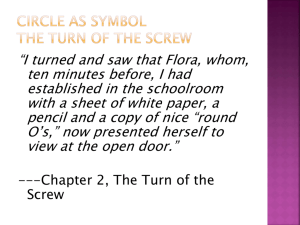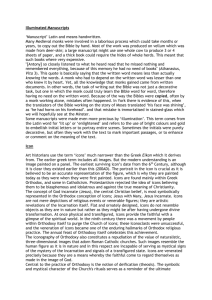Flower Symbolism
advertisement

The Language of Flowers Scent and Symbolism Certainly no one will dispute that when we think of a wedding, we think of flowers. Their scent and their color are an almost irreplaceable element of your wedding decor. Whether you select simple arrangements and floral touches, or you go all out, flowers will lend an air to your wedding that no other decoration can quite match. Many brides and grooms select their flowers based purely on color. Some also consider the type of flowers to set a mood. Roses create a far different feeling that wildflower combinations. Some make selections on the bride's favorite flower or because of budget constraints. There is no right or wrong when it comes to flowers, so long as the rules of good taste and common sense are followed. There may also be a bride and groom who take another point into consideration when making their floral selections. That is what has come to be the meaning of individual flowers, the language of flowers which has come down to us through history. The symbolic and legendary meanings of flowers dates back to the Elizabethan era, but it was the Victorians who actually assigned simple messages to individual flowers. Flower Language was Introduced to the Swedish court in 1714 by Charles II, and the Victorian mode of flower language spread quickly throughout Europe. This was a period where expressions of feeling were restricted by etiquette and conformity, so men and women came to use the beauty and color of flowers to express emotions which they could not express in other ways. Flowers became a vehicle for the expression of wishes and thoughts. Flower selection became a carefully thought about and planned activity, so that the appropriate sentiment, though or wish could be conveyed without being spoken. To enhance this Flower Language, presentation also became important and the clever gift-giver could add even more meaning in this way. An upside-down bouquets, for example. could be used to express the opposite meaning of the flowers. To receive an inverted rose was easily understood to mean rejection. Flower Language became so much a part of the social culture of the times that durch die Blume sprechen (speaking through flowers) actually became a Western proverb that meant any flowery or poetic expression hiding a secret message of love. Should you be one of those for whom the Language of Flowers still holds meaning, then the list below will help you to determine the message that your wedding flowers will convey to those "in the know." You may even choose to explain the meaning to your guests by way of a card placed at each table. Apple Blossom signifies better things to come. Aster is Latin for "star," and refers to the flower's star-like shape. Bird of Paradise Botanists are divided on how this flamboyant flower got its name. Some claim that the flower's brilliant orange and blue blossom, resembling a bird in flight, is named after the bird of paradise itself — one of the most beautiful bird species in the world. Calendula The calendula's genus name, wor calendae, means "throughout the months." " In the language of flowers, the calendula flower symbolizes "winning grace." Camelia symbolizes gratitude. Carnation Originally called dianthus by the Greek botanist Theopharastus, the carnation is native to the Near East and has been cultivated for the last 2,000 years. Some historians believe that the name "carnation" comes from "coronation" or "corone" (meaning flower garlands), because it was one of the flowers used in Greek ceremonial crowns. Chrysanthemum in red, says "I love you" and in white, symbolizes truth. Cyclamen symbolizes modesty and shyness. Daisy The daisy's name comes from the Anglo-Saxon "daes eage," or "day's eye," which refers to the way the flower opens and closes with the sun. The daisy is knows as a symbol of childhood innocence. Daffodil symbolizes regard. Forget-me-not symbolizes true love and remembrance. Heliotrope symbolizes devotion and faithfulness. Honeysuckle symbolizes generosity. Hyacinth symbolizes loveliness. Hydrangea symbolizes boastfulness. Iris symbolizes warm affection. Ivy symbolizes eternal fidelity. Japonica symbolizes loveliness. Jasmine symbolizes amiability. Lemon Blossom symbolizes fidelity in love. Lilac (White) symbolizes youthful innocence. Lily symbolizes majesty Lily of the Valley The Lily of the Valley foretells the return of happiness. Magnolia symbolizes perservance. Maidenhair symbolizes discretion. Mimosa symbolizes sensitivity. Orange Blossom symbolizes purity and virginity. Orchid The orchid's name derives from the Greek word "orchis," meaning "testicle." Its history is associated with lust, greed, and wealth. Some orchids are called "ladies' fingers," "ladies' tresses," or "long purples.". Peach Blossom symbolizes a captive heart. Red Rose symbolizes love. * Yellow Rose symbolizes friendship. * Coral Rose symbolizes desire. * Peach Rose symbolizes modesty. * Dark Pink Rose symbolizes thankfulness. * Pale Pink Rose symbolizes grace. * Orange Rose symbolizes fascination. * White Rose symbolizes innocence. Rosemary symbolizes remembrance. Snowdrop symbolizes hope. Sweet Pea symbolizes delicate pleasures. Tulip status symbol for the rich. The tulip originated as a wildflower in Persia. In the 1500s, tulips were extensively cultivated in Turkey. Based on their resemblance to the "tulbend," a turban worn by Turkish men, they were called tulipan. In 1562, tulip bulbs from Constantinople reached Antwerp by ship. Before the turn of the century, tulips had been so rare that only the wealthiest that in Holland could afford them. It was for this reason that tulips became an obvious status symbol for the rich. Color messages abound with tulips which primarily express a declaration of love in a gift from a lover. Variegated tulips are for "beautiful eyes." Red tulips indicate an irresistible love, and yellow tulips indicate hopeless love that has no chance of reconciliation. Tulips that are combined in color express other messages, Red and yellow roses together are an expression of congratulations, while yellow and orange roses together imply passionate thoughts. Red and white roses signify unity. Veronica symbolizes fidelity. Violet symbolizes faithfulness Should you choose to add a message to your weddings, you now know the Language of Flowers and may convey their sentiment and symbolism to others. FLOWERS HOT TIPS Queen Victoria started the romantic gesture of including ivy in the bridal bouquet. After the wedding the ivy can be rooted and then planted as a living reminder of your special day. Perhaps, it might become part of your own daughter's bouquet on her wedding day.






